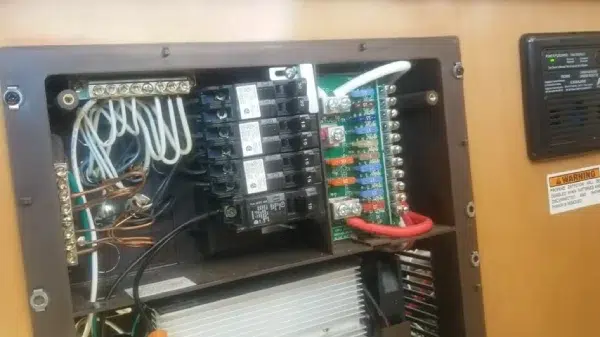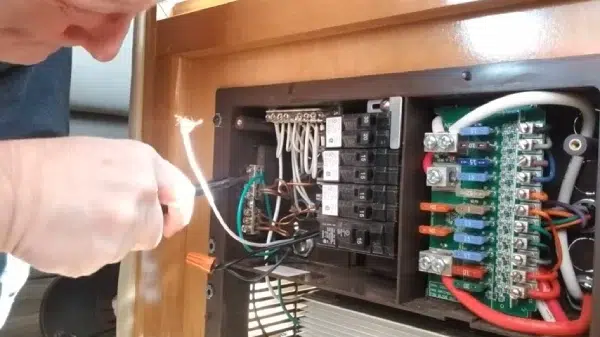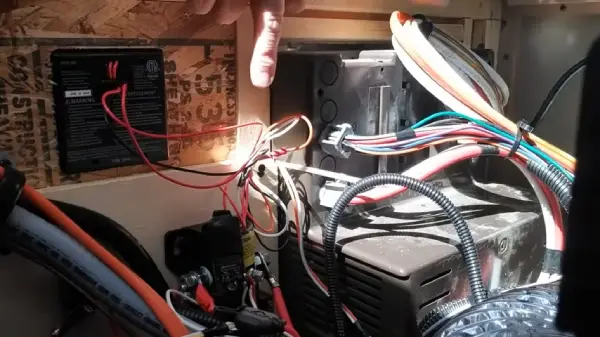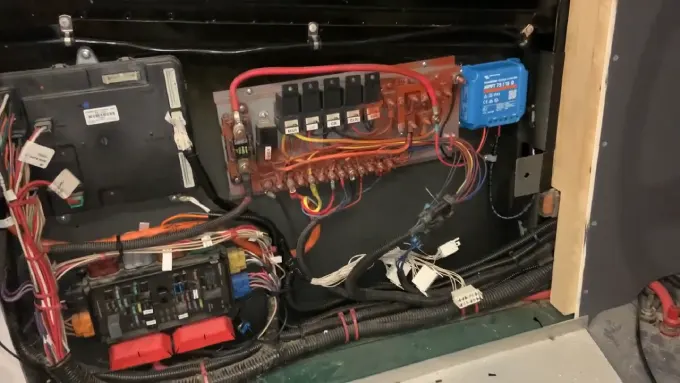Last Updated on May 3, 2023
Traveling by RV opens up a world of possibilities, providing both convenience and comfort. But while hitting the open road is an experience like no other, many newbies may find themselves wondering if their RV’s battery will be charged once they set off on that next big adventure.
It’s an important question, as having a charged chassis battery is essential for starting the vehicle. While most RVs charge the battery when plugged in, not all do. This is particularly true with smaller motorhomes.
Join us as we tackle the essential issue of maintaining your RV’s battery charge and get ready for an exciting excursion. We’ll provide all the information you need to ensure nothing prevents you from hitting those breathtaking destinations.
Does RV Chassis Battery Charge When Plugged In: Answer in Detail

The battery does charge when plugged in. However, some factors can affect the charging process.
RVs typically have two types of batteries: a house battery and a chassis battery.
Firstly, let’s understand how an RV charging system works. When the engine runs, the alternator charges the chassis and house batteries. Shore power is the only way to charge both batteries when the RV isn’t running.
Now, when plugged into shore power, most RVs have a converter that converts AC power to DC power and charges both sets of batteries. However, some older models may only charge the house batteries and not the chassis battery.
The house battery powers all of the appliances and electronics inside the RV, while the chassis battery powers the engine and other components necessary for driving. When an RV is not plugged in, the engine’s alternator charges the chassis battery while driving.
When an RV is plugged into shore power, it uses a converter to convert AC power from the campground or outlet into DC power to charge both the house and chassis batteries. The charging process for both batteries occurs simultaneously but at different rates.
The house battery usually charges faster because it has a higher capacity and draws more power.
Charge Process for RV Chassis Batteries: Factors That Can Affect It
Several factors can affect the charging process of an RV chassis battery when it is plugged in. The most important factor is the condition of the battery itself. If the battery is old or damaged, it may not hold a charge properly, even when plugged in.
A fully discharged battery may take longer to charge than one that’s partially charged.
Another factor that can affect the charging process is the type of charger being used. Some chargers are designed to charge batteries quickly, while others are designed to provide a slow and steady charge over a longer period. Use a charger that’s right for your battery and charging needs.
The length of time that the battery is left plugged in can also affect its charging process. If the battery is only plugged in for a short period of time, it may not have enough time to recharge fully. On the other hand, if the battery is left plugged in for too long, it may overcharge and become damaged.
Finally, external factors such as temperature and humidity can also affect the charging process. Batteries tend to charge more slowly in colder temperatures and faster in warmer temperatures. Humidity can also impact how quickly a battery charges by affecting its internal resistance.
By understanding how these various factors can affect your RV chassis battery’s charging process, you can take steps to ensure that your battery stays healthy and fully charged when you need it most.
Signs that indicate a problem with the RV chassis battery charging system
One of the most critical components of your RV’s electrical system is the chassis battery. It powers various functions in your RV, such as the engine and other essential systems that keep you on the road. Therefore, ensuring that your chassis battery is always charged is essential.
Sometimes, you may notice symptoms of a bad charging system. Here are some of them:
- Dimming lights: If you notice that your RV’s interior or exterior lights are dimmer than usual, it could be a sign that your chassis battery is not charging correctly. This issue can occur due to a faulty alternator or converter.
- Slow cranking: When starting your RV’s engine, if it takes longer than usual for it to start or if it cranks slowly, this could indicate a low battery charge.
- Battery warning light: If the battery warning light on your dashboard comes on while driving or starting up your RV, this indicates an issue with the charging system.
- Battery age: The chassis battery may need to be replaced if it is more than three years old and shows any of these signs.
If you notice any of these signs, it is crucial to address them immediately to avoid further damage or potential breakdowns on the road.
Tips for Maintaining Your RV Chassis Battery While Charging

Maintaining your RV chassis battery is essential to ensure it functions properly and lasts as long as possible. Here are some tips to help you keep your battery in good condition:
- Regularly Check the Water Level: Most RV batteries require distilled water to function properly, so it’s important to check the water level regularly and refill it if necessary. Low water levels can cause damage to the battery plates and reduce its lifespan.
- Keep the Battery Clean: Dirt and debris can accumulate on the battery terminals, which can cause corrosion and prevent proper charging. Clean the terminals with a wire brush and a mixture of baking soda and water.
- Use a Battery Maintainer: A battery maintainer helps keep the battery charged when not in use by providing a low-level charge that won’t overcharge or damage the battery. This is especially important during long periods of storage.
- Avoid Overcharging: Overcharging can cause damage to your RV chassis battery, so make sure you don’t leave it plugged in for too long or use an incompatible charger.
- Disconnect When Not In Use: If you’re not using your RV for an extended period, consider disconnecting the battery entirely to prevent any parasitic draws that could drain its charge.
What RV Owners Do Wrong When Maintaining Their Chassis Batteries?
When it comes to maintaining your RV chassis battery, there are certain mistakes that you should avoid to keep it functioning properly. Here are some common mistakes that RV owners make:
- Allowing the battery to discharge too much: It’s important to keep your RV chassis battery charged, but if you let it discharge too much, it can damage the battery and reduce its lifespan. Make sure to recharge the battery before it gets too low.
- Overcharging the battery: Overcharging can also shorten the battery’s life. Make sure not to leave your RV plugged in for extended periods of time without checking on the battery’s charge level.
- Not using a smart charger: A smart charger is designed to automatically adjust the charging rate based on the current state of the battery. Using a regular charger can overcharge or undercharge the battery, which can lead to damage.
- Ignoring warning signs: If you notice any warning signs that indicate a problem with your RV chassis battery, such as slow cranking or dimming lights, don’t ignore them. Addressing these issues early on can prevent further damage and save you money on repairs.
- Failing to maintain proper water levels: Check and maintain proper levels regularly if your RV chassis battery requires water. Low water levels can cause damage and reduce the lifespan of your battery.
What Charges the Chassis Battery On An RV?

The chassis battery on an RV is responsible for powering critical systems in the vehicle, including the headlights and turn signals. The vehicle utilizes an alternator to ensure that the battery remains charged and ready to perform.
The alternator generates electrical power along with the engine in an RV’s charging system. The alternator harnesses this power to make electricity, which is fed back into the vehicle’s electrical system. This energy is used to recharge the chassis battery and supply power to other systems in the RV.
It is important to note that the alternator charges the chassis battery while the vehicle is in motion under normal driving conditions. The battery may discharge if the RV is parked for a long time without being driven. It’s best to use a battery maintainer or trickle charger to keep the battery charged.
How Often should an RV chassis battery need to be charged?
As we know, ensuring the proper maintenance of your chassis battery is crucial to avoiding unforeseen breakdowns and expensive repairs. Typically, a good chassis battery would only require charging every few months.
However, depending on the electrical components connected to your RV, power may continue to drain even when the vehicle is not in use.
It is essential to note that the frequency at which you need to charge your chassis battery is not set in stone. Instead, it is something you will need to learn by monitoring the battery’s discharge rate over time.
Once you understand how fast your chassis battery discharges, you can create a charging schedule that suits your vehicle’s specific needs.
To extend the life of your chassis battery, it is also recommended that you establish a battery maintenance routine. This might involve checking the battery’s electrolyte levels, ensuring proper cable connections, and cleaning any corrosion build-up on the battery terminals.
It’s worth noting that leaving a chassis battery uncharged for an extended period can cause irreversible damage and necessitate replacement. Therefore, it’s crucial to prioritize charging your battery regularly to avoid costly and preventable repairs.
Get Your RV Moving with a Fully Charged Battery
Before heading out on the open road, it’s essential to understand how your RV chassis battery works. This powerful power source is what keeps you going during those long trips and adventures. So ensure each journey starts with ensuring this all-important resource is in tip-top shape.
It’s important to know that there are different charging processes for the engine alternator and shore power. However, regardless of the method, you can avoid problems by monitoring your battery regularly and avoiding overcharging or undercharging.
Problems with charging could also be indications of faulty wiring or a damaged converter, so it’s crucial to address those issues early on. With these precautions in mind, you’ll be able to maintain a reliable power source for your RV and enjoy your adventures with peace of mind.



